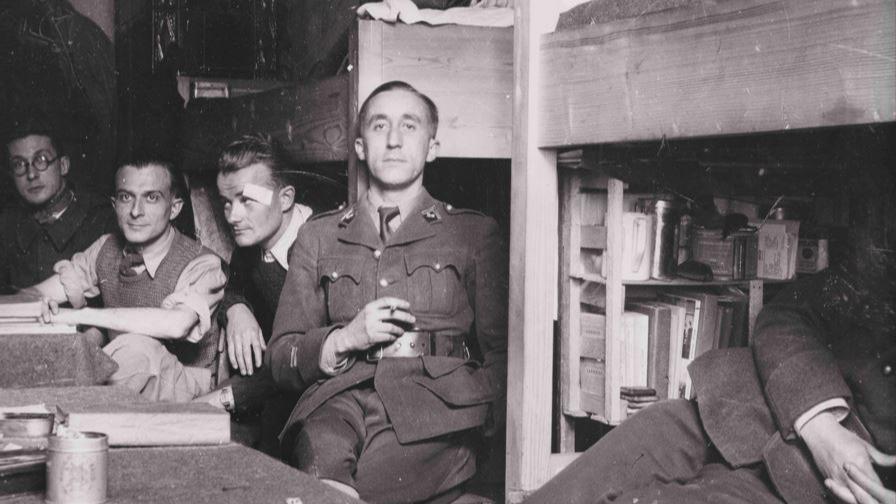After the end of the war, Moosburg's Stalag VII A was converted into an internment camp under American control.
A historian now sheds light on its history.
Moosburg
- From 1945 onwards, numerous people were taken to the Moosburg internment camp by the American occupying forces - including war criminals and officials of the Third Reich.
In a comprehensive digital lecture on Wednesday, Dominik Reither dealt with the everyday life of internees and re-colored this long-neglected topic with new insights.
A book will also be published soon.
According to Reither, his findings are supported by numerous documents, witness statements and the files from military intelligence services.
Although the topic is basically a bit “bulky”, the findings from it help to understand how the National Socialists were dealt with after the war.
US forces fear partisan fighters
The idea behind such internment camps was simple: above all, security. Because the Americans were definitely afraid of possible partisan fights and at times met fanatical resistance. In addition, and Reither pointed out that the occupiers could see how Germans treated their own people in the final phase of the war - for example, hanging people who had hoisted a white flag. There were also calls for guerrilla struggle, for example from Wilhelm Keitel - or Joseph Goebbels' werewolf campaign, which was supposed to take action against occupiers. In the area around Landshut, depots with weapons and ammunition for such resistance actions were found. Another, albeit weaker, motive: the denazification of the German population,which should be led to a democracy.
+
Camp inspection by Major General Horace McBridge before handing over to the German administration on October 10, 1946.
© National Archives USA
The camps were divided into different blocks in order to separate groups such as women or war criminals.
But who came into the camp anyway?
There was also an “arrest catalog” that was used to arrest party officials, SS officers, Gestapo personnel, and industrialists who had supported the regime.
Since the prisons were unsuitable for internment, the Americans used, for example, the concentration camp in Dachau and the Stalag VII A prisoner-of-war camp in Moosburg to arrest their prisoners.
+
The Moosburg historian Dominik Reither is working on the history of the camp.
© Lorenz
From June 1945 to April 1948 there were up to 10,000 people in the Civilian Internment Camp No 6 in Moosburg.
The conditions in the camp itself were initially rather bad, especially with the diet of 900 calories per day.
However, the struggle for the food soon improved, so that the supply in the camp was at times even better than for the people outside.
Background: The Americans definitely wanted to avoid their internment camps being seen as concentration camps.
Reither sees the 62 deaths during this time as very well documented, including six suicides and four shootings while attempting to escape.
According to his research, those 1000 dead, which are mentioned again and again, are to be seen symbolically for the lost lifetime in the camp.
Theater and bookkeeping courses in the warehouse
Open letter from the USA appeals to Moosburg's responsibility
In the memory debate about the Stalag VII A in Moosburg, a feasibility study was recently presented. At the same time, an emotional letter made the rounds.
In the camp itself, which was initially run loosely by the Americans and later by Germans, various cultural programs such as theater performances or courses in accounting were developed relatively quickly. A camp library was also on site, in which, however, Adolf Hitler's “Mein Kampf” was found. Sports activities were abundant, and church parishes were also founded. If contact with the outside world was initially completely cut off, these restrictions gradually relaxed - up to and including visits to the camp. Nevertheless: According to Reither, the mood was probably not the best. Many internees felt harassed by the Americans and at the mercy of a foreign power.The insight into one's own mistakes and the confrontation with National Socialism was probably largely lacking. Here, according to Reither, the Americans also neglected to show the prisoners, for example, photographs or films from concentration camps - the Nuremberg trials were only marginally discussed. Training on a democratic understanding took place little or much too late. So, according to Reither, it is not surprising that so many people retained that basic attitude: National Socialism was basically good, but only poorly implemented.Training on a democratic understanding took place little or much too late. So, according to Reither, it is not surprising that so many people retained that basic attitude: National Socialism was basically good, but only poorly implemented.Training on a democratic understanding took place little or much too late. So, according to Reither, it is not surprising that so many people retained that basic attitude: National Socialism was basically good, but only poorly implemented.
+
Church congregations were also established in the camp, as this photo illustrates.
© W. Rott
In conclusion, Reither addressed the question of how internment camps should be assessed.
One thing should be noted very clearly: the difference to concentration camps was considerable.
The internees, at least at a later point in time, were no worse off in terms of supplies than the civilians in post-war Germany.
However, criticism could be leveled at the Americans because, according to Reither, they had "no plan" for how things should proceed after their arrest.
Many a prisoner was mistaken
In his opinion, the chance to influence the prisoners with basic democratic teaching and dealing with the atrocities was wasted.
From an administrative point of view, too, many things went much too slowly - even when internees were mixed up, which were rare but still occurred.
Not to forget: resistance fighters were also wrongly there.
Every single fate must be viewed individually - because internment in the Moosburg camp does not automatically mean that the prisoner was a National Socialist, explained Dominik Reither.
If you want to find out whether relatives have been accommodated in Civilian Internment Camp No 6, you should contact the State Archives in Munich, there is an internment file, which is not complete.
Richard Lorenz
Good to know
If you want to find out more about the Moosburg internment camp, you can soon buy the non-fiction book "Civilian Internment Camp No 6" by Dominik Reither.
More information and pre-orders at www.stalag-moosburg.de/buch.
On the subject:
An exhibition that is physically set up in the Moosburger Vhs and published virtually, recently commemorated the liberation of Stalag VII A.
Here you can see the virtual presentation.
Also worth reading:
Mini-supermarkets have been displaced for years.
Two siblings are now defying this trend with a new corner shop in Moosburg.
The customers are thrilled.
Freising newsletter: Everything from your region! Our brand new Freising newsletter informs you regularly about all the important stories from the Freising region - including all the news about the corona crisis in your community. Sign up here.









